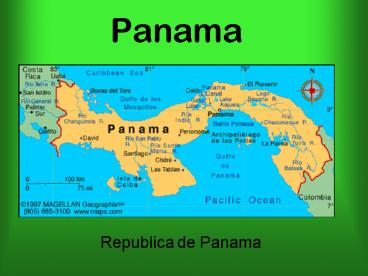Panama - PowerPoint PPT Presentation
1 / 10
Title:
Panama
Description:
Panama. Republica de Panama ~Officially adopted on November 3,1903 ~Modeled after the USA flag ... independence in 1921 the USA agreed to pay compensation of ... – PowerPoint PPT presentation
Number of Views:902
Avg rating:3.0/5.0
Title: Panama
1
Panama
- Republica de Panama
2
Officially adopted on November 3,1903Modeled
after the USA flag
Conservative Party
Peace
Liberal party
3
Economy
- Agriculture Sugar cane, coffee and bananas
- Banking, insurance, government, and oil
Most of the economy is service based using the
canal as an exchange port Exports Bananas,
shrimp, coffee, clothing Imports Capital goods,
food, consumer goods, chemicals
4
Economy cont.
- Literacy Rate 93
- Unemployment 8.7
- Population 3,242,173
- Growth rate 1.6
- Capital Panama City
Weather On the Caribbean side of Panama there is
rainfall all year usually 60-140 inches The
lowest temperature all year is 78 degrees There
are more tropical rainforests on the Caribbean
slopes due to the rainfall, while there are
savannas in the southern part
5
The People
- Languages
- Spanish (official)
- English (14)
Ethnicity Mestizo 70 Mixed Spaniard and
Filipino American Indian 14 White 10 Indian
6
Religion Roman Catholic 85 Protestant 15
6
Culture
- Panama adopted food and culture from South and
Central America, the Caribbean, and Asia. - Food reflects Colombian, U.S. and Caribbean food
- Caribbean rhythms and North American rock are
more popular than traditional Hispanic music
7
History
- Rodrigo de Bastidas, was sailing westward from
Venezuela in 1501 in search of gold, landed on
the Isthmus of Panama and was the first European
to discover Panama - A year later, Christopher Columbus visited the
isthmus and established a short-lived settlement - In 1513 the isthmus was realized to be the path
between the seas and Panama became the
marketplace of Spains empire in the New World - Gold and silver were being brought up from South
America and put on ship for Spain. The route
became known as the Royal Road. - The native Cuevas and Cocole tribes quickly
disappeared after the Spanish arrived with their
weapons and diseases in the early 16th century - All of the wealth from the silver and gold
attracted pirates and caused shippers to sail
around Cape Horn to Peru which made Panamas
importance decline - Spain then did not recognize Panama as a province
of Colombia and they won their independence from
Spain in 1821
8
History
- Panama achieved independence in 1821, as a region
of Gran Colombia, which also included Colombia
Venezuela, Ecuador, Peru and Bolivia. When Gran
Colombia collapsed in 1830, Panama became part of
modern Colombia - They did not want to be a part of modern Colombia
so they allied with the United States since the
US wanted to create an Atlantic-Pacific link
through Panama - A deal was signed with the US in 1846, that
allowed for the construction of a railway. But it
was not until 1903 and full independence of
Panama from Colombia that the Americans started
on the construction of the Panama Canal - Colombia finally recognized Panamas independence
in 1921 the USA agreed to pay compensation of 25
million for Panama to Colombia
9
History
- The Panama canal zone became and American owned
land. The canal was completed on August 15,
1914. Panama remained under effective American
control until 1939. - During most of the 1980s, the country was run by
Torrijos former intelligence chief, Manuel
Noriega - After an attempted coup of Endara by Noriega in
October 1989 believed to have had US backing
Endara was quickly crushed by Noriegas forces.
The only way of getting rid of the dictator was
military intervention. in December 1989, George
Bush authorized an invasion of the country - After a few days of fighting the US got control
of the country and captured Noriega and he was
brought back to America and sentenced to jail. - Five years later Panama had an election and
created a four party government and pledged to
create a free trade agreement with the US - The government consists of a 71 member
legislature and executive branch. Presidents are
elected every five years and they appoint cabinet
ministers
10
The Canal
- On December 31, 1999 the Torrijos-Carter
agreement was signed which transferred full
control to Panama. - The Canal measures 52 mile from Colon, in
Caribbean, to Panama City on the Pacific. It
usually takes 8 to 10 hours to cross - It took 10 years to build with a work force of
75,000 men and women. - Approximately cost 400 million.































